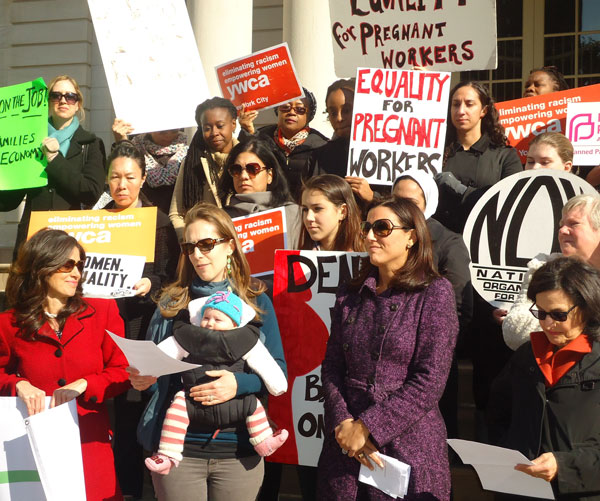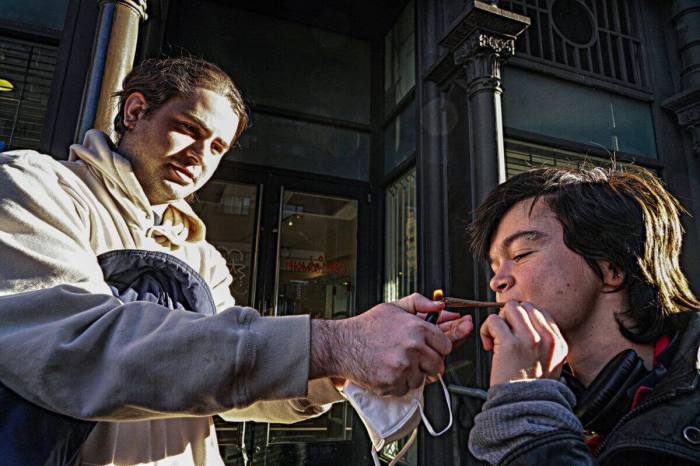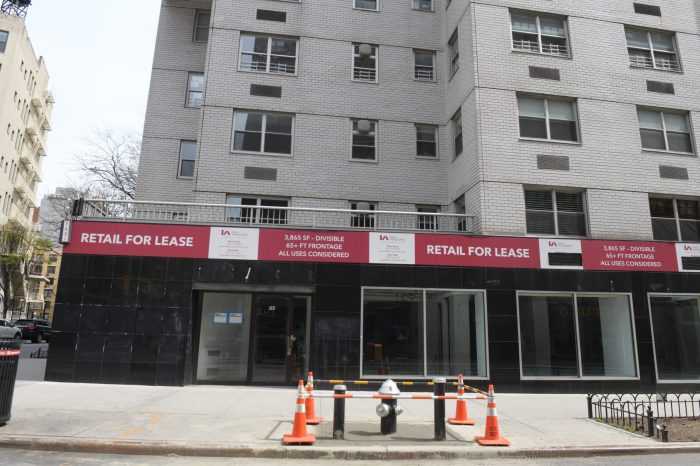BY WINNIE McCROY | The 2014 legislative session got off to a good start on January 27, when it passed the Women’s Equality Act (WEA) — to ensure that New York’s 10 million women achieve full equality, including the right to make their own decisions about their reproductive health and access to abortions. But the legislation now faces a Republican-controlled Senate, where those beholden to right-wing and Tea Party constituents do not want to see it pass. Supporters recognize that this may be an uphill battle.
“Unfortunately, it doesn’t seem that much has changed,” said New York State Senator Brad Hoylman. “The Assembly passed the bill last session and did so again last month. I remain hopeful that the Senate will move all ten points to the floor, but I’m afraid that Republicans may again cave to the extreme right-wing and prevent the women’s choice provision from coming to the floor.“

The legislation, A.8070, also passed the Assembly in 2013, but failed to pass in the Senate due to a combination of it being introduced in the last few days of the 2013 session, and the unwillingness of Republicans to pass point 10 of the legislation. Last year, this reproductive health legislation was introduced as a hostile amendment as Senate Bill 4174, but was ruled not germane on a vote of 32-30. Things will take a different turn this year if Assemblymember Deborah Glick has anything to do with it.
“We decided to introduce it very early this year, to give organizations with statewide membership a few months to really work the bill,” Glick told Chelsea Now. “So we passed it in the second week. The governor certainly has taken a public posture that we should pass the 10 points.”
Glick noted that in 2013, while the proposed legislation did pass the Assembly, the actual bill had not been available for distribution. She said that, although it had been discussed, those who were clearly anti-choice or religiously conservative had used the lack of a physical bill to spread erroneous information about the legislation.
“We were hamstrung in our ability to refute their claims, because the bill hadn’t been introduced,” said Glick. “When it was finally introduced, it was at the very end of the session, so regardless of how broadly things were discussed, there really wasn’t an actual bill to act upon.”
As soon as the legislation was made available, the Assembly debated and passed it with 98 yes votes — meaning that there were a lot of ‘no’ votes, and not just from Republicans, either.
While some of the proposed parts of the legislation tackling pay equity or domestic violence had floated around the Assembly for several years, they had not successfully moved to the Senate. When gathered together in the Women’s Equality Act, some of the proposed points were amended to become more voter-friendly. For example, while some Republican members of the Assembly voted ‘no’ year after year on pay equity adjustments to sick leave to care for sick family members, when the legislation was retooled as “Family Leave Time,” it was much more successful.
These changes have made the WEA more palatable to conservative forces; except, of course, the reproductive health freedoms outlined in point 10.
WHAT DOES THE LEGISLATiON DO?
The Women’s Equality Act is a piece of legislation that strives toward full equity for women. The 10 points cover issues including securing pay equity, enacting a zero-tolerance policy for sexual harassment in the workplace, removing housing discrimination based on family status, providing reasonable accommodations for pregnancy-related conditions, protecting domestic violence victims accessibility to orders of protection, strengthening human trafficking laws and ensuring that women have the freedom to choose in New York.
A detailed outline of the 10 points is as follows:
1. Strengthening laws that require Equal Pay for Equal Work: Women in New York earn only 84 percent of what men earn, and are paid significantly less than jobs predominantly employing men. The WEA would close a loophole that allows employers to pay women less, and increase damages for prevailing litigants to 300 percent of unpaid wages.
2. Ending Sexual Harassment on the Job: In 2011, women filed 75 percent of all sexual harassment complaints with the NYS Division of Human Rights. Businesses with less than four employees — 60 percent of private employers in New York State — are exempt. The WEA would prohibit sexual harassment for ALL workplaces.
3. Allowing for Attorney’s Fees in Employment, Credit, and Housing Sex Discrimination Cases: Women file approximately 77 percent of employment cases based on sex, and the majority of credit and lending discrimination cases. But if you can’t afford an attorney, you can’t seek redress. The WEA would allow for litigants who win a sex discrimination suit to collect attorney’s fees.
4. Ending Familial Status Dis-crimination: State law already prevents against familial status discrimination in housing and credit, but not employment. Women with children are less likely to be hired, losing an average of $434,000 over a 40-year career. The WEA would outlaw discrimination against parents in the workplace.
5. Ending Discrimination in Housing Based on Domestic Violence Victim Status & Source of Income: More than one in three women will experience rape, physical violence or stalking by an intimate partner. Female-headed households account for 76 percent of all housing vouchers, including Section 8. The WEA would prohibit discrimination in leasing, selling or eviction because a tenant is a domestic violence victim, and would create a task force to study its impact.
6. Ensuring that Victims of Domestic Violence are Not Punished for “Violating” their own Order of Protection: Women get an order of protection against an offending party, and are then arrested when that party violates said order. The WEA would stop this.
7. Creating a Pilot Program for Remote Access to Orders of Protection: Protective orders end 33-77 percent of domestic violence. But in order to get an order of protection, a victim must testify before their abuser in court. The WEA would allow them to testify remotely.
8. Strengthening Laws Against Human Trafficking: Women and girls are trafficked into labor or prostitution, but few perpetrators are held accountable. The WEA would increase penalties, create an affirmative trafficking defense in the case of prostitution charges and create a civil action for victims against their perpetrators.
9. Ending Pregnancy Discrimination: Pregnant women in low-wage, physically demanding jobs are often given the boot or forced into unpaid leave when they request temporary accommodations like more restroom breaks or a stool. The WEA would require employers make reasonable accommodations.
10. Safeguarding Reproductive Health: The Supreme Court passed Roe v. Wade in 1973, but New York’s laws were enacted in 1970. Under state law, a woman’s health isn’t protected in the case of serious complications that jeopardize her health. The WEA would ensure that a woman can access an abortion in New York State if her health is at risk.
Point 10 is where the contention lies. In the 1970s, New York passed abortion rights, prior to the U.S. Supreme Court decision in Roe v. Wade. The legislature failed to codify this federal law. The Women’s Equality Act would codify existing federal law to protect a woman’s right to obtain an abortion prior to 24 weeks, or in cases where the woman’s life or health are endangered. It would ensure that physicians cannot be criminally prosecuted for providing such care, and it retains provisions to prosecute those who harm pregnant women.
GOP WON’T CODIFY ROE V. WADE IN NY
“The hold-up is codifying a woman’s right to choose,” said Hoylman, adding that he believed it was “disgraceful” that the leadership of the Senate was keeping this provision from making it to the floor for a vote.
“Women in New York State deserve to know where their senators stand on reproductive health,” said Hoylman. “It’s a basic healthcare right that’s been affirmed by the U.S. Supreme Court, so it’s understandable the urgency of advocates who want a vote on all ten points.”
Last year, independent Democrats in the Senate assisted in defeating the bill when they empowered Republicans to be given a veto over what legislation would come to the floor for a vote. They then argued that liberals introduced the so-called “hostile amendment” to add reproductive legislation, after the 10-point package had been agreed upon.
“My sense is that despite what I understand was an initial agreement on the ten-point package, Senate Republicans refused to touch the codifying of the 1973 court decision,” said Assemblymember Dick Gottfried. “I think that puts them way out of line with the majority of New Yorkers, but that’s where they’ve aligned themselves.”
Hoylman credited his colleagues in the Assembly for recognizing the importance of all ten points of the Women’s Equality Act, including the tenth point that has held up action in the Senate: a woman’s right to choose.
“It’s pretty shocking that in this day and age that the Senate leadership is refusing to bring to the floor legislation that would codify in state law Roe v. Wade — a Supreme Court decision that is over forty years old,” said Hoylman.
WHY NOT A PIECEMEAL APPROACH?
Some have argued that the strategy to break the legislation up like this was good, as the Senate was willing to pass nine out of the ten points. But Glick noted that it was the wrong strategy for anyone who wanted to pass legislation around a woman’s right to choose.
“They passed the nine points and said how great they were on women’s issues, when they were terrible on [them],” said Glick, who made references to the ‘inside baseball’ that surrounded the 2013 package. “Now, we should just go back and do it right. You can’t say it’s a Women’s Equality Bill when what’s left out is the right to make our own healthcare decisions.”
Gottfried echoed this sentiment, saying that the problem with breaking the legislation into individual pieces was that it made it that much easier for Senate Republicans to walk away from the reproductive health piece of the legislation.
“That’s why the caucus of women in the Assembly has been standing firm for keeping all 10 pieces together, and the Democratic men have been standing with them,” said Gottfried.
Hoylman echoed this sentiment, saying that while he would take the lead of the advocates who’ve been working on these issues for decades, as well as his Senate conference leader Andrea Stewart-Cousins, he believed that strategically, they should not settle for only nine provisions of the ten-point plan. The openly gay senator drew parallels to the fight for transgender inclusion in the Sexual Orientation Nondiscrimination Law (SONDA).
“The argument I’ve heard against voting on the provisions of WEA piecemeal compares it to [SONDA], the state gay rights law,” he explained. “Transgender people were left out of SONDA to help secure passage on the theory they could be added later. More than a decade later, however, this hasn’t happened and as a result you can still legally discriminate against transgender people in parts of New York.” Sometimes, you don’t get the chance to go back for the ones you left behind.
LEGISLATON HAS CUOMO’S SUPPORT
Part of the difficulties of getting the Women’s Equality Act passed last year had to do, ironically enough, with the overwhelming support of incoming Governor Andrew Cuomo, who pushed for the legislation during his 2013 State of the State address.
“New York State is the equality capital of the nation, but we still have more to do…because not everyone has reached full equality in our society. We passed marriage equality; let’s make history again and pass the Women’s Equality Act in the State of New York,” said Cuomo excitedly during his 2013 State of the State address. “We have a 10-point agenda…but we need to protect a woman’s freedom of choice. We need to enact the reproductive health act, because it’s her body, it’s her choice.”
This support was welcomed, but according to Gottfried, it is fairly common for program bills from a governor to arrive in the legislature fairly late in the session. Last year’s package went through considerable negotiations among the governor, Assembly and Senate, which was the main reason it was introduced so late in the session. This year’s early passage in the Assembly bodes well for its passage.
“The governor plays an indispensible role here, and the fact that he put the 10-point package on the agenda in his January 2013 State of the State speech was enormously effective and important,” said Gottfried.
Hoylman agreed that the governor deserved a tremendous amount of credit for making the Women’s Equality Act the centerpiece of his legislative agenda last year, noting that, “he remains the guiding force.”
Women’s groups, gathered under the auspices of the New York Women’s Equality Coalition (NYWEC), also praised Cuomo’s support of the legislation, noting that 89 percent of New York voters agreed that equal pay for women should be a high priority, and 80 percent supported updating New York’s abortion law.
“We are thankful the Governor highlighted the Women’s Equality Act today, especially his acknowledgment that nothing changed for women in 2013,” said Christine Sadowski on behalf of the coalition. “We are hopeful that working together with him, and all legislators, we can move towards greater equality for women in 2014.”
LOBBYING IN AN ELECTION YEAR
One thing that further complicates matters is the fact that this is an election year for the New York State legislature. Lawmakers tread carefully when dealing with passage of legislation that may turn their constituents against them in the streets — and in the polls.
“Election years can produce unexpected results,” said Gottfried. “Fortunately, the power of the Tea Party is dramatically less in New York State than in many other states. We are not Kansas. But it’s early in the process, and I and other advocates for the full package are optimistic that public sentiment will prevail and the whole package will pass.”
What improves the legislation’s chances of passage is that this is the second year that the package has been on the agenda, and it has much wider public awareness than it did during most of 2013. There is time for public debate, and for lobbyists to sway legislators toward its importance.
“It is a live bill, and organizations enmeshed in wanting various aspects of the bill to be passed now have the opportunity to use the entire session to advocate in their districts to get the full 10-point package taken up for a vote in the Senate,” said Glick.
NARAL, an organization that split with the other women’s coalition groups last year after they considered cutting out the reproductive health act, is one group that will lobby actively for the entire WEA legislation package to be passed. While the woman’s equality coalition is not involved in electoral politics, NARAL’s Andrea Miller said that her group would target key senators in pro-choice districts who oppose the reproductive health act in the November elections.
All this, and the more the better, said Glick. Although the WEA is a great start, with “a number of different things in there that make life easier for families, many of whom are headed by single working moms,” what the bill doesn’t address and what Assemblywomen are still concerned about is access to high quality child care, paid family leave and the rising cost of higher education.
“Those are issues that continue to be of concern,” said Glick. “There are a broader array of things that are not included in this legislation, but they are still part of the discussion that women in the Assembly are having.”
For now, however, securing the passage of the WEA is a task that these legislators are cautiously optimistic will happen, if only they can successfully navigate the perils of Tea Party Republicans, pro-life opponents, religious zealots and election-year jitters.
“I can’t really predict what will happen,” said Hoylman. “I remain hopeful, but given that it’s an election year, it certainly complicates the equation for the Republicans, who may be afraid of reprisals from the right-wing and the Tea Party.”



















